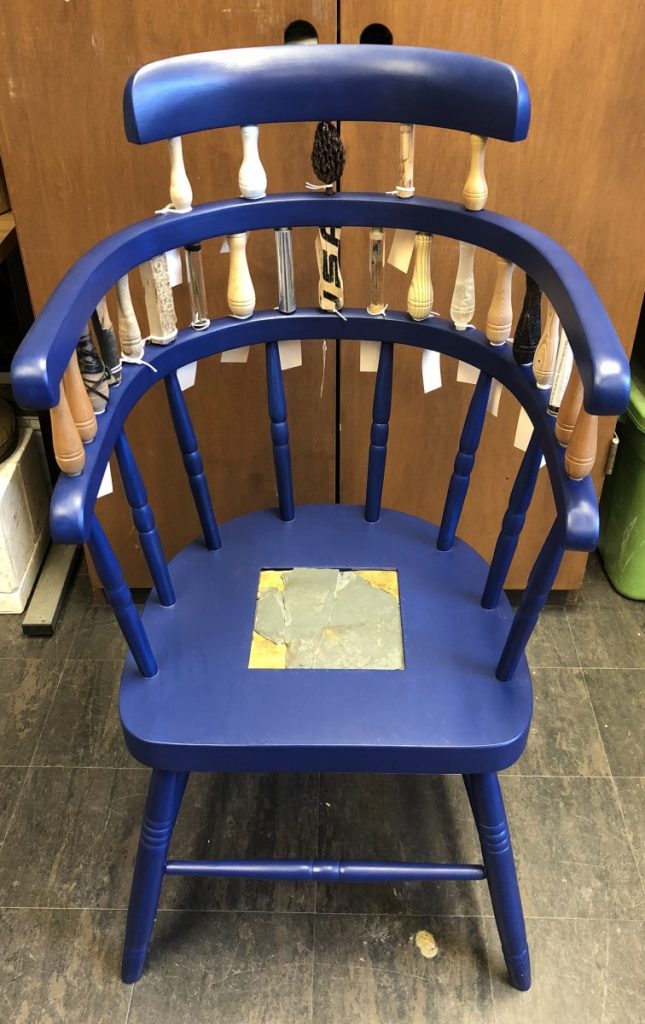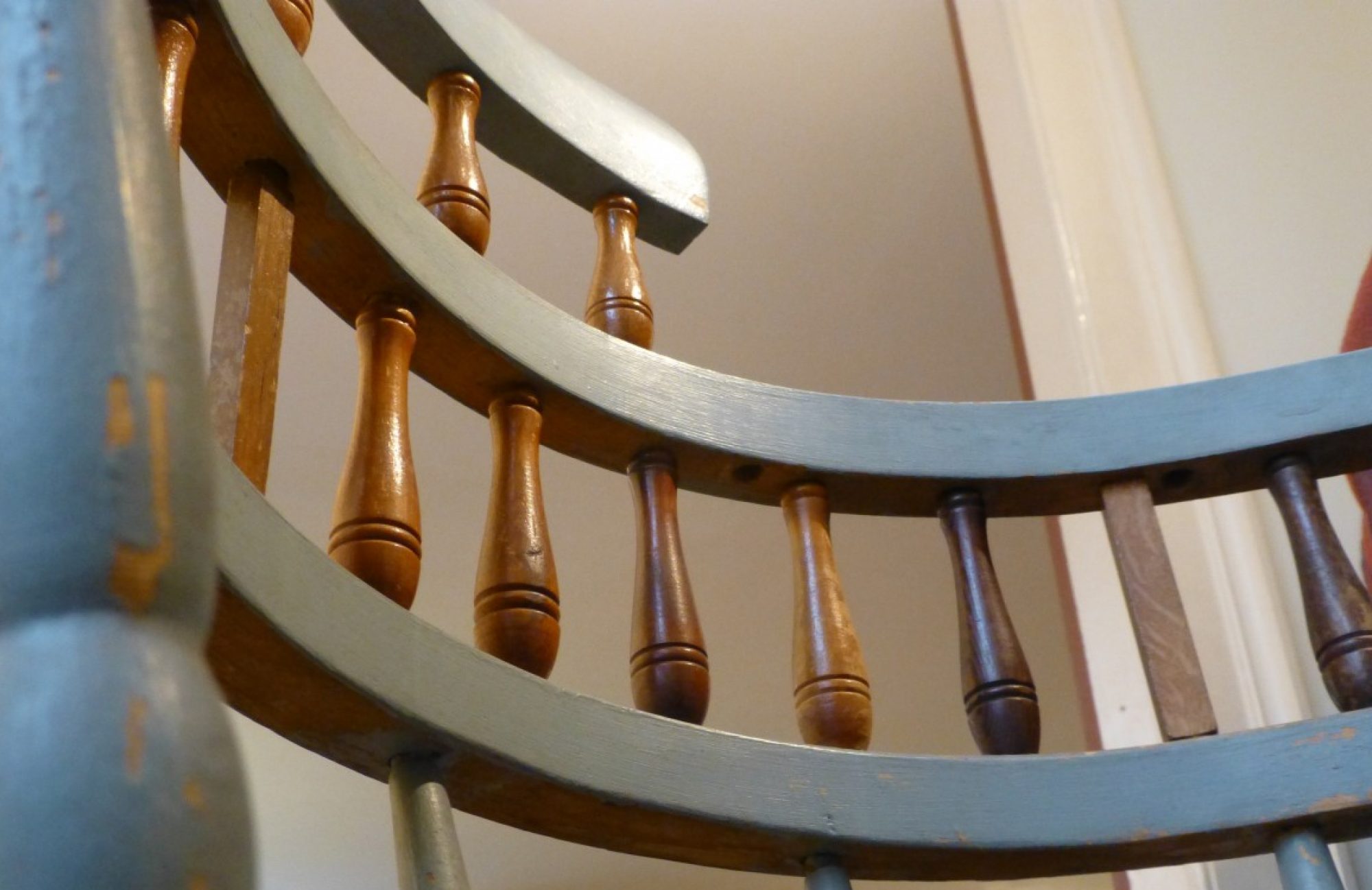
Just as Henry Sheldon incorporated “relics” that had relationships to places and people of local, national, and historical interest, our class brainstormed about what objects could convey the complexities of our own time. Some of the spindles are related to the students’ favorite activities: fragments from the ski patrol hut and lodge of the Middlebury Snow Bowl, wood from the local tavern, a hockey stick to represent the centrality of athletics to Middlebury College culture. When students were asked to think of objects that embodied Middlebury’s history and traditions, one of the first things that came to mind was “Gamaliel Painter’s cane,” a walking stick donated by an early trustee who saved the College with a timely financial donation; the cane is still fetishistically passed around at Convocation and Commencement ceremonies, and graduating students receive a copy of the cane from the Alumni Association. While we obviously could not cut a piece from Painter’s cane (carefully guarded by the President’s office!), we brainstormed other strategies and decided to create a 3-D scan of the original and digitally print it, thereby creating a new object that still had an indexical relationship to Painter’s original and incorporated 2018 technologies (the President’s office graciously lent the cane for the process).
One of New England’s most famous inhabitants, Robert Frost, had not yet achieved fame during Sheldon’s lifetime. We honored him (and his connection to Middlebury) by including a branch collected from the grounds of his Ripton farm.
We also wished to reflect critically upon our past and present. While Sheldon’s inclusion of a piece of wood from former President Andrew Johnson’s tailor shop evoked the trope of the self-made man rising from poverty to public office, it also served as a physical link to a controversial historical figure, given Johnson’s impeachment and debates over failed Reconstruction policies. Students considered moments of more recent controversy and thought it would be important to include a reference to the debates surrounding Charles Murray’s invitation to speak at Middlebury in March 2017, events that brought the college into the national news spotlight. We were able to obtain a handout distributed to protesters at the event and folded it within an acrylic tube, saving it like a time capsule (portions of the text are still legible, even as it serves as a spindle).
Students also discussed the significance of environmental issues to both their Middlebury experiences and our historical moment. While some highlighted recreation and their love of the natural world (e.g., driftwood from the creek where one student frequently fished), others thought about the college’s emphasis on environmental sustainability. To this end, we included wood chips from the college’s Biomass plant, embodying the school’s commitment to sustainable practices—but also recent controversies over the means by which the administration proclaimed success in achieving its goal of becoming “carbon neutral.” The recent wildfires in California were also on our minds, and so we set about attempting to acquire an object that had been affected by these disasters. While Henry Sheldon’s inclusion of a piece of California redwood was perhaps motivated by its status as an “exotic” species from far away, the charred piece of redwood fencepost in our 2018 chair could evoke issues of climate change and the challenges faced by humans and the natural world. In this way, the chair both referred to Sheldon’s original and spoke to our own historical moment.
We expanded our use of materials beyond wood to include objects of importance to Vermont and to the students personally. Marble has long been an important resource for Vermont’s culture and economy, and Colin Boyd deftly carved a spindle from a fragment from the local marble works (today transformed from an industrial site to a shopping center). A student who loved bicycling included handlebars from the college’s bike shop, where students can exchange parts and learn skills of bicycle maintenance. When we asked Governor Jim Douglas for a donation of an object to include in the chair, he and Vermont State Curator David Schutz generously sent us a square of gilded copper sheathing from the State House dome, currently undergoing renovations and restoration.
Students also discussed the ways in which Sheldon’s chair foregrounded the white settler history of Vermont and contemplated ways to change that in their own chair. While we thought it could be powerful to include an object that referred to Vermont’s rich Abenaki heritage and continuing native presence, we were concerned about the insensitivity of asking for a “fragment” of a Native object to be included in our chair, fearing that it only replicated past injustices rather than working towards a collaborative and equitable future. Students did, however, wish to include an object that would honor Middlebury’s first graduate of African descent, Alexander Twilight, and Bob Hunt of the Old Stone House Museum graciously brought us a section of a floor joist from the Orleans County Grammar School, where Twilight taught and preached.
Like Sheldon’s chair, our 2018 relic chair relied upon a network of collaborators and contributors. A few months after the class had ended, I read of a dramatic storm that brought down a tree planted by George Washington; Mount Vernon curator Adam Erby kindly sent us some wood from this historic felled tree. The expertise of craftsmen and artists was crucial: chairwright Tim Clark built a gorgeous copy of the body of Sheldon’s chair, and art studio technician Colin Boyd was instrumental in the success of the project, brainstorming with students about how to transform the raw materials they collected into beautiful and functional spindles, and teaching us the skills to do so. He collaborated with me after the semester was over to continue crafting pieces that weren’t yet finished. In addition to opening their archives to us for research, the Sheldon Museum hosted an exhibition of the two chairs with didactic materials, including our website and a video about the project (September 2018-April 2019). We have plans to bring the exhibition to Montpelier’s Vermont Historical Society in the spring of 2020 as well, sharing the project beyond the college community and our small town. Please see the “Acknowledgments” page for more information.

– Ellery E. Foutch
Upper row, Left – Right:
- 1. Middlebury Snow Bowl Lodge, Ripton, VT – contributed by Grayson Ahl and Pate Campbell
- 2. Marble from Marble Works, Middlebury, VT – contributed by Colin Boyd
- 3. Magnolia seed pod from Andrew Johnson National Historic Site, Greeneville, TN – contributed by Ellery Foutch
- 4. Wood chips from Middlebury College BioMass Plant – contributed by Wayne Hall via Chris Bradbury
- 5. Red cedar carved by students in our first wood-turning session with Colin Boyd (Sheldon’s original chair included a fragment of red cedar from the Benson whipping post)
Lower row, L-R:
- [6 and 7: structural]
- 8. Laurie Patton’s earbuds – contributed by Laurie Patton via Ryan Rudolph
- 9. Branch from Robert Frost’s Farm, Ripton, VT – contributed by David McDaniel
- 10. Driftwood from Otter Creek, Middlebury, VT – contributed by Luke Peterson
- 11. Orleans County Grammar School, where Alexander Twilight taught and preached, Brownington, VT – contributed by Bob Hunt, Curator, Old Stone House Museum, via Harry Rich
- 12. 3-D print from a scan of Gamaliel Painter‘s original cane, with thanks to Laurie Patton, Barbara McBride, Spencer Tonies, Colin Boyd, and Weston Uram
- 13. Fragment of wood from Battell Hall, Middlebury College, named after Joseph Battell – contributed by Eric Sun
- 14. Handlebars from the Middlebury Bike Shop – contributed by Noah Fine
- 15. 1960s Hockey stick used by Middlebury College hockey team – contributed by Bill Beaney via Lubomir Cuba
- 16. Fragment of wood from the Ski Patrol Hut, Middlebury Snow Bowl – contributed by Pate Campbell
- 17. Wood from grounds of Two Brothers Tavern, Middlebury, VT – contributed by Trevor Schmitt
- 18. Wood shavings from Tim Clark‘s workshop, Waltham, VT – contributed by Tim Clark
- 19. Wood from the Boardroom of Old Chapel, Middlebury College – contributed by Wayne Hall via Peter Martin
- 20. California redwood, from fence burned in 2017 wildfires, Mendocino County, CA – contributed by Ann and Jessica Horton via Ellery Foutch
- 21. Canadian hemlock planted by George Washington circa 1785 and brought down in storm of March 2018, Mount Vernon, VA – contributed by Mount Vernon Associate Curator Adam Erby via Ellery Foutch
- 22. Poster from protests of 2 March 2017 Charles Murray talk – contributed by Assistant Professor J Finley via Ellery Foutch
- [23 & 24: structural]
Seat
- Gilded copper sheathing from Vermont State House dome, Montpelier, VT – contributed by Governor Jim Douglas and Vermont State Curator David Schutz via Colin Flaherty
- Slate shingle from roof of Sunderland Hall, Middlebury College (where the class met)

You must be logged in to post a comment.